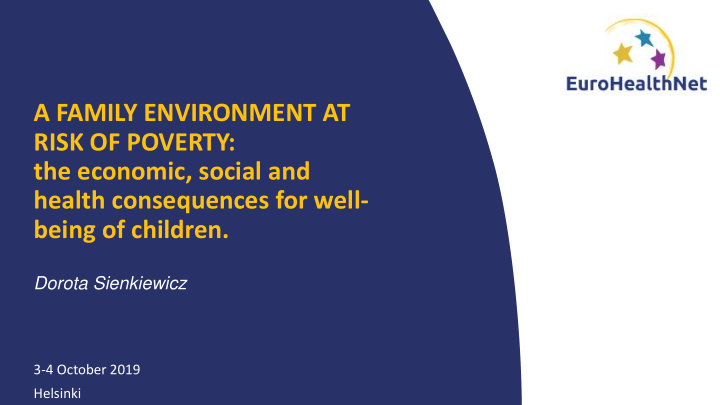



A FAMILY ENVIRONMENT AT RISK OF POVERTY: the economic, social and health consequences for well- being of children. Dorota Sienkiewicz 3-4 October 2019 Helsinki
ABOUT EUROHEALTHNET Over 60 members, associate members and observes 28 European countries Our mission • Reducing health inequalities • Social determinants of health Our approach • Life-course approach • Social determinants of health • Social Gradient • Health in All Policies • Sustainable Development Goals
ADVOCACY FOR COMPREHENSIVE SYSTEMS AND APPROACHES: focus on children and inequalities • With an at-risk-of-poverty or social exclusion rate of 24.9 % in the EU-28, children were at greater risk in 2017 than the total population (22.4 %). • The percentage of children living in a household at risk of poverty or social exclusion ranged from less than 15.0 % in Denmark and Czechia to more than 40 % in Bulgaria (41.6 %) and Romania (41.7 %). • The disadvantages for children in their early life, but also their lasting effects: childhood poverty and social exclusion can and do leave health, emotional and social ‘marks’. • Unmet medical and dental need higher for the poorest children (Eurostat 2019). Increasing out-of-pocket payments push families (more) into poverty.
ECONOMIC CONSEQUENCES OF POVERTY AND INEQUALITY FOR WELLBEING OF CHILDREN • Decline in economic and social productivity, security and cohesion, and lead to higher healthcare and welfare costs (remedial, benefits). • In the EU, inequalities in health are estimated to cost 980 billion EUR per year, or 9.4% of EU GDP. 50% reduction in life expectancy gaps would provide 0.3 - 4.3% GDP monetized benefits to countries.
SOCIAL AND HEALTH CONSEQUENCES OF POVERTY AND INEQUALITY FOR WELLBEING OF CHILDREN: research • GRADIENT: In all European societies, for every step down the socio-economic ladder children and young people experience a higher level of physical and mental health problems that will affect their future health and life opportunities. • The poorer the more socioemotional difficulties (already at age 3-5). High familial affluence is significantly associated with higher health and mental wellbeing. • DRIVERS: Underlying causes (from 183 studies): parental occupational social class, lower parental educational attainment, neighbourhood deprivation, higher parental job strain, lower parental income/wealth, household material deprivation, poor quality housing. => no space to learn, play; poor cultural and social networks; poor nutrition; language.. • Although estimates vary, a number of studies suggest that social and environmental factors account for between 40-60% of variation in health outcomes. Acting on non-healthcare determinants of health would address 90% of health inequalities within a lifetime of a single government. (WHO Europe HESRi 2019)
RESEARCH FINDINGS: DRIVERS and GRADIENT
CHILDREN’S HEALTH and WELLBEING: EU tools, policies, processes • EU Treaties, Charter of Fundamental Rights, UN Convention on the Rights of the Child; as part of the SIP EC Recommendation on Investing in Children. • Creating political and fiscal environments where investing in human capital, skills, people, lifecourse is seen as investment, not a burden. Boosting resilience, social protection and cohesion. Investing in families. • European Semester and the EU Pillar of Social Rights, the SDGs agenda (review and recommendations, investment priorities, action plan) • Children’s health and wellbeing in the (next) EU Budget (ESF+, Child Guarantee, Cohesion Funds/ERDF, InvestEU, HorizonEurope, DigitalEurope, CAP..) • How does the future look like: new EU institutions, New Strategic Agenda 2019- 2024, post EU2020 strategy, Economy of Wellbeing under the Finnish Presidency.
CHILDREN’S HEALTH and WELLBEING: what practices are there? • DIATROFI Project (Greece): Food aid and healthy nutrition programmes in schools: what works? • Public Health Wales: A system wide approach to improving outcomes in First 1000 Days. Cwm Taf wellbeing plan as part of the 2015 Wellbeing Future Generations Act: the whole public sector is working together: health, police, education, social, probation, and fire and rescue services are collaborating along with the national government and the natural resource agency. By mapping the situation together, they will be able to understand the situation, what is needed to create change, and agree on priority actions. • Nossa Senhora do Bom Sucesso Foundation (Portugal): An integrated health monitoring model for good, lifelong health. • Spanish Health Promotion and Prevention Strategy: launched in 2013, combines health promotion, ‘positive parenting’, and life -course approaches. • DoRS working group on health inequalities and early childhood interventions (Italy): Preventing is caring: a focus on Early Child Development interventions http://eurohealthnet-magazine
REFLECTIONS • Universal policies are more likely to be effective in reducing poverty and socio-economic gradient in health and wellbeing than targeted policies (broad enough to have a population-wide impact). But: proportionate universalism – according to needs, special reach-out since the poorest are least likely to use the system. • Due to economic constraints in all EU member states, universal public services are being reduced/funding cut in favour of targeted ones (likely to hit those who are already the worst off). 53% of Euro governments disinvesting in housing. • Risk: developing “poor services for the poor”. • Evaluate distributional impact of policies, health equity impact assessments. • Health equity and wellbeing indicator to monitor progress on (next)EU strategy. • Integrated services (but: healthcare sector most resistant), increasing role of health providers in addressing determinants of health. • Foresight, evidence-based policymaking, whole of government but coordinated and clearly demarcated line of accountability.
SOCIAL AND HEALTH CONSEQUENCES OF POVERTY AND INEQUALITY FOR WELLBEING OF CHILDREN EuroHealthNet published a video on the First 1000 life- changing days of child’s life (in collaboration with the EU Alliance for Investing in Children) https://youtu.be/rj3FhN-mfFw
Recommend
More recommend